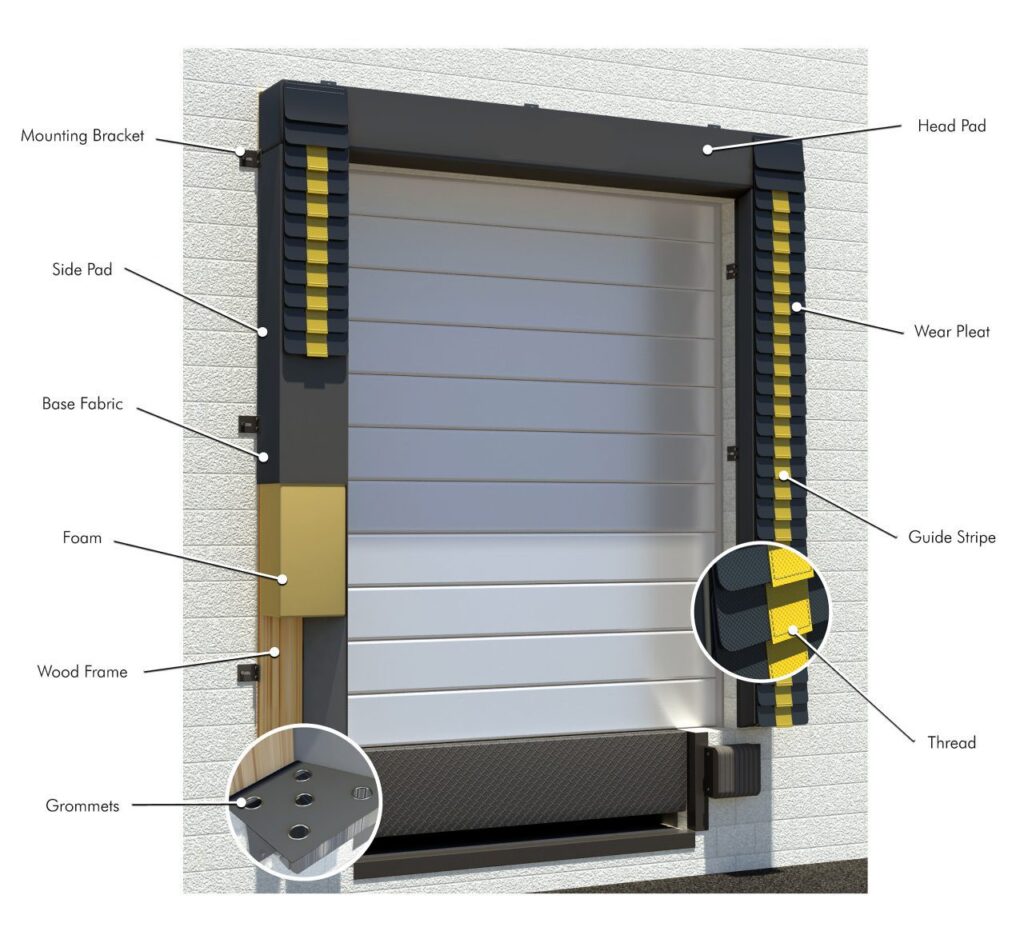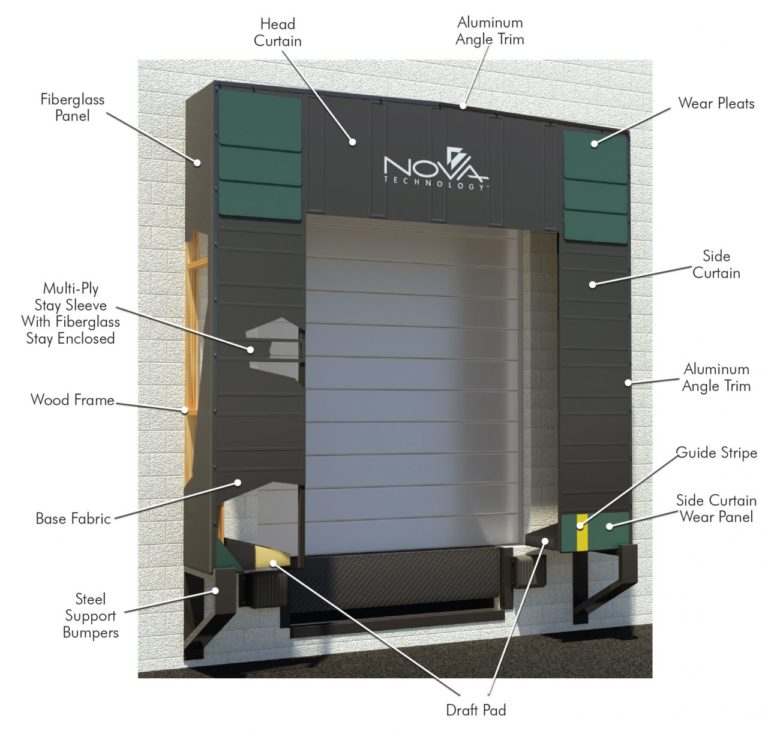DOCK SEAL AND DOCK SHELTER INSTALLATION
The Dock Seal is like putting weather stripping on your loading dock. It is designed to efficiently seal the perimeter space between the truck trailer and the loading dock walls. Dock seals are ideal for cold storage, food and pharmaceutical applications where a barrier against energy loss, dirt and pests is a must.
The foam-filled head pad and side pads provide a tight, energy-efficient seal between the trailer and dock wall providing protection from inclement weather, dirt and insect infiltration.
- Cover material and wear pleats are top-grade fabrics providing superior performance and maximum durability
- High-density polyurethane foam provides long life and excellent resiliency characteristics
- Foam is bonded with high strength adhesive to select grade pressure-treated, kiln-dried wood framing for long-lasting installation
- Heavy-duty galvanized mounting hardware
- Brass grommets with spur washers for venting
- Velcro® brand attachments
- All sew lines are locked stitched utilizing heavy bonded polyester multi filament thread with UV protectant for extended life
- Full-height yellow guide stripe standard
Operation
Dock seals can significantly improve the energy efficiency and environment control of buildings, reducing costs. They provide an effective barrier against the elements, keeping loading docks safe and efficient.
Dock seals provide a positive seal between internal and external environments. They prevent the passage of dust, insects, exhaust fumes and other airborne particulate matter while the loading dock is in use.
Structural
Dock Seals are constructed from high density polyurethane foam and solid wood. Cover material and wear pleats are top-grade fabrics providing superior performance and maximum durability.
Safety Features
Dock seals help avoid safety and productivity problems associated with unprotected openings, such as:
- Employee discomfort
- Energy loss
- Theft or security concerns
- Product damage or contamination
- Insect infiltration
- Slippery or dangerous dock conditions

Options
- Wear pleats
- Wear face
- Scuff guards
- Bottom door flaps (1 to 3 sides)
- Drop curtains
- Pull rope system for drop curtains
- 2″ foam-filled drop curtains
- Flame retardant foam & fabric
- Top corner pleats only
- 24″ high yellow guide stripe
- Blockouts
- Galvanized metal backs
- Chain weighted drop curtain
- Beveled head pads
Dock Shelters
Dock shelters provide a positive seal between internal and external environments. They prevent the passage of dust, insects, exhaust fumes and other airborne particulate matter while the loading dock is in use.

Dock Shelter—provides maximum dock protection and full access to trailers while minimizing pressure on the building wall. The RF Series features high wear-resistant fabric with double lock-stitched seams, bottom corner draft pads and standard 36 inch drop head curtain with fiberglass stays, protective corner reinforcement pleats and wind retention straps. The raked header with translucent fiberglass top provides natural light, permits water drainage, and provides snow load support.
- Select grade pressure-treated, kiln-dried wood side and head frame
- Frames covered with translucent fiberglass
- Aluminum angle face edging
- Cover material and wear pleats are top-grade fabrics providing superior performance and maximum durability
- Vinyl covered foam “drop in” style draft pads
- Steel support bumpers (black)
- Heavy-duty galvanized mounting hardware
- 15-inch yellow guide stripe standard
- All sew lines are locked stitched utilizing heavy bonded polyester multifilament thread with UV protectant for extended life
Operation
Dock shelters can significantly improve the energy efficiency and environment control of buildings, reducing costs. They provide an effective barrier against the elements, keeping loading docks safe and efficient.
Dock shelters provide a positive seal between internal and external environments. They prevent the passage of dust, insects, exhaust fumes and other airborne particulate matter while the loading dock is in use.
Structural
Dock shelters are constructed from solid wood frames or galvanized steel. Cover material and wear pleats are top-grade fabrics providing superior performance and maximum durability.
Safety Features
Dock shelters help avoid safety and productivity problems associated with unprotected openings, such as:
- Employee discomfort
- Energy loss
- Theft or security concerns
- Product damage or contamination
- Insect infiltration
- Slippery or dangerous dock conditions
Options
- Full-height yellow guide stripes
- Shelter projection—24″ standard, customizable to any projection
- 2″ foam front head curtain
- Pull rope system
- Hook and loop splits on head curtain
- Head curtain drop over 54″
- Frame cut-outs for obstructions
- Non projecting frame
- Common member units
- Ground level units
- 18 oz. white vinyl on frames
- Galvanized steel frame
- Clear roof panels for extra lighting
- Chain weighted drop curtain
- Spring steel stays
FAQs
What is the difference between a dock seal and a dock shelter?
A dock seal creates a tight, foam-padded seal around the trailer opening, while a dock shelter uses a flexible curtain system that allows full trailer access and accommodates a wider range of vehicle sizes. Seals offer better insulation; shelters provide greater versatility.
How do I choose the right dock seal or shelter for my loading area?
The choice depends on your dock traffic, door size, trailer variety, and insulation needs. For tighter seals and climate control, dock seals are ideal. For high-volume or varying trailer heights and widths, a dock shelter is a better fit.
Can dock seals be used with different trailer sizes?
Dock seals work best with standard-size trailers. If your facility handles a wide range of trailer sizes, a dock shelter or a customized seal with options like beveled head pads or drop curtains may offer better performance.
How do dock shelters improve energy efficiency?
Dock shelters minimize air exchange between the warehouse and outdoors, reducing HVAC loss. They keep conditioned air inside while blocking dust, insects, and weather, helping maintain internal temperature and air quality.
